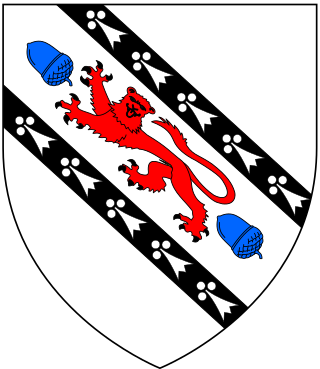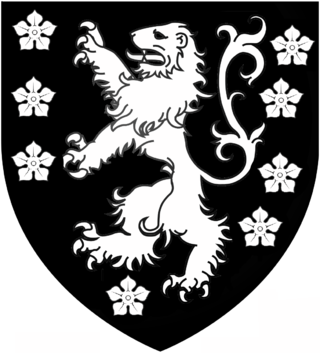Related Research Articles

Viscount Scarsdale, of Scarsdale in Derbyshire, is a title in the Peerage of the United Kingdom. It was created in 1911 for the prominent Conservative politician and former Viceroy of India George Curzon, 1st Baron Curzon of Kedleston, who was created Earl Curzon of Kedleston at the same time and was later made Marquess Curzon of Kedleston.

Earl of Scarsdale was a title in the Peerage of England. It was created in 1645 for Francis Leke, 1st Baron Deincourt, an ardent supporter of Charles I during the Civil War. He had already been created a baronet, of Sutton in the County of Derby, in the Baronetage of England on 25 May 1611, and Baron Deincourt, of Sutton in the County of Derby, in the Peerage of England in 1628. His grandson, the third Earl, was a politician and courtier. In 1680, one year before he succeeded his father in the earldom, he was summoned to the House of Lords through a writ of acceleration as Baron Scarsdale. He was childless and was succeeded by his nephew, the fourth Earl. He was the son of the Honourable Richard Leke, younger son of the second Earl. He served as Lord Lieutenant of Derbyshire. He never married, and the titles became extinct on his death in 1736.

The Anderton Baronetcy, of Lostock in the County of Lancaster, was a title in the Baronetage of England. It was created on 8 October 1677 for Francis Anderton of Lostock Hall in the parish of Bolton le Moors, Lancashire. The Andertons of Lostock were descended from the ancient family of Euxton Hall, near Chorley, Lancashire. They acquired Lostock by marriage in the 13th century. They were a devout Roman Catholic family and their estate was lost by sequestration in 1615 due to recusancy but was restored after the English Reformation to Francis Anderton the first Baronet. The third, fourth, fifth and sixth Baronets were brothers. On the death of the third Baronet, his heir, his brother Lawrence, a Benedictine monk succeeded to the Baronetcy but relinquished his claim to the Lostock estate. However his younger brother Francis, a Jacobite, was convicted of High Treason for his part in the Battle of Preston (1715) and the estate was again lost by sequestration. Lawrence returned from France, renounced his Catholicism and successfully reclaimed the estate. Francis was pardoned and on his death succeeded to the Baronetcy but he did not recover the estate which passed to his sister and her husband. The Baronetcy became extinct on the death of Sir Francis in 1760.
There have been two baronetcies created for people with the surname Jenkinson, both in the Baronetage of England. The seventh holder of the first creation was elevated to the peerage as Earl of Liverpool in 1796, a title which became extinct in 1851.

There have been three baronetcies created for persons with the surname Burdett, two in the Baronetage of England and one in the Baronetage of Ireland. As of 2008, two of the creations are extant while one is dormant.
There have been six Forster Baronetcies, four in the Baronetage of England, one in the Baronetage of Ireland and one in the Baronetage of the United Kingdom. All are extinct.
There have been five baronetcies created for persons with the surname Evans, one in the Baronetage of Ireland and four in the Baronetage of the United Kingdom. All of the baronetcies are now extinct.

The Baronetcy of Gresley of Drakelow was created in the Baronetage of England on 29 June 1611 for George Gresley of Drakelow Hall, Derbyshire who was later High Sheriff of Derbyshire and Member of Parliament for Newcastle-under-Lyme.
The Kniveton Baronetcy, of Mercaston in the County of Derby, was a title in the Baronetage of England. It was created by King James I on 29 June 1611 for William Kniveton of Mercaston Hall, Muggington, Derbyshire. The family originated in the village of Kniveton,, from where their name derived. Branches of the family later had seats at Bradley and by virtue of the 15th century marriage of Nicholas Kniveton, at Mercaston, near Muggington, Derby

There have been three Baronetcies created for persons with the surname Seymour, two in the Baronetage of England and one in the Baronetage of the United Kingdom. One creation is extant as of 2008.

There have been two Charlton Baronetcies:-

The Hunloke Baronetcy, of Wingerworth in the County of Derby, was a title in the Baronetage of England. It was created on 28 February 1643 by King Charles I for Sir Henry Hunloke, of Wingerworth, near Chesterfield, Derbyshire. Hunloke was a loyal royalist who had been knighted by the King on the battlefield of the Battle of Edgehill the previous year. The baronetcy passed from father to son until the death of the sixth Baronet in 1856. The latter was succeeded by his uncle, upon whose death in 1856 the baronetcy became extinct. The second Baronet was High Sheriff of Derbyshire in 1687 and the sixth Baronet in 1840.
Sir Francis Foljambe, 1st Baronet was Member of Parliament for Pontefract in 1626 and High Sheriff of Derbyshire in 1633.

There have been three baronetcies, all in the Baronetage of England, created for members of the Spencer family, both for descendants of two younger sons of Sir John Spencer (1524–1586) of Althorp, Northamptonshire.
The Coke baronetcy of Longford, in the County of Derby was created in the Baronetage of England on 30 December 1641 for Edward Coke.

The Rodes Baronetcy, of Barlborough in the County of Derby, was a title in the Baronetage of England. It was created on 14 August 1641 for Francis Rodes, of Barlborough Hall, near Chesterfield, Derbyshire. The early family of Rodes was seated in Nottinghamshire. A William Rodes acquired an estate in Derbyshire by marriage. Sir Francis Rodes built Barlborough Hall in 1583–4. The first Baronet was his grandson. The title became extinct on the death of the fourth Baronet in 1743, when the estates passed to his sister's heirs, the Heathcotes and Heathcote-Rodes families.
Walton Hall is a late 18th-century country house, now a farmhouse, situated at Foljambe Avenue, Walton, Chesterfield. It is a Grade II listed building.

Two unrelated baronetcies have been created in the surname of Clifton.
There have been two baronetcies created for persons with the surname Burton, one in the Baronetage of England and one in the Baronetage of Ireland. Both creations are extinct.

Sir Godfrey de Foljambe was a prominent landowner and politician in fourteenth-century England, who was a Baron of the Exchequer and chief steward of the duchy of Lancaster. He went on to have a successful career as an Irish judge, including three years as Lord Chief Justice of Ireland. He was initially a servant of Philippa of Hainault before becoming a prominent member of the affinity of her son, John of Gaunt, Duke of Lancaster. His tomb can still be seen at All Saints Church, Bakewell.